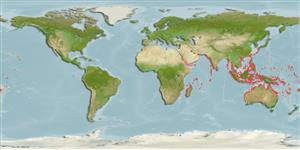>
Carangiformes (Jacks) >
Carangidae (Jacks and pompanos) > Trachinotinae
Etymology: Trachinotus: Greek, trachys, -eia, -ys = rough + Greek,noton = back (Ref. 45335).
Eponymy: Marcus Élieser Bloch (1723–1799) was a German physician and naturalist specialising in ichthyology. [...] (Ref. 128868), visit book page.
More on author: Lacepède.
Environment: milieu / climate zone / depth range / distribution range
Ecologia
marinhas; estuarina associadas(os) a recifes; intervalo de profundidade 1 - 7 m (Ref. 5439). Tropical; 31°N - 35°S, 30°E - 157°W
Indo-Pacific: Red Sea and East Africa (Ref. 3287) to the Marshall Islands and Samoa, north to southern Japan, south to Australia.
Length at first maturity / Tamanho / Peso / Idade
Maturity: Lm ?, range 58 - ? cm
Max length : 110 cm FL macho/indeterminado; (Ref. 1602); common length : 40.0 cm TL macho/indeterminado; (Ref. 3280); peso máx. Publicado: 3.4 kg (Ref. 40637)
Espinhos dorsais (total) : 7; Raios dorsais moles (total) : 18 - 20; Espinhos anais: 3; Raios anais moles: 16 - 18.
Juveniles inhabit sandy shorelines and shallow sandy or muddy bays near river mouths while adults move out in schools to clear seaward coral and rock reefs (Ref. 5213). Juveniles are in small schools, while adults are usually solitary (Ref. 48635). Adults feed primarily on sand mollusks and other hard-shelled invertebrates (Ref. 9710).
Life cycle and mating behavior
Maturidade | Reprodução | Desova | Ovos | Fecundidade | Larvas
Paxton, J.R., D.F. Hoese, G.R. Allen and J.E. Hanley, 1989. Pisces. Petromyzontidae to Carangidae. Zoological Catalogue of Australia, Vol. 7. Australian Government Publishing Service, Canberra, 665 p. (Ref. 7300)
Categoria na Lista Vermelha da IUCN (Ref. 130435: Version 2024-2)
Ameaça para o homem
Reports of ciguatera poisoning (Ref. 30911)
Utilização humana
Pescarias: pouco comercial; Aquacultura: espécies comerciais; peixe desportivo: sim; Aquário: Aquários públicos
Ferramentas
Relatórios especiais
Descarregue XML
Fontes da internet
Estimates based on models
Preferred temperature (Ref.
123201): 24.8 - 29.3, mean 28.4 °C (based on 3759 cells).
Phylogenetic diversity index (Ref.
82804): PD
50 = 0.5000 [Uniqueness, from 0.5 = low to 2.0 = high].
Bayesian length-weight: a=0.02630 (0.01463 - 0.04729), b=2.83 (2.68 - 2.98), in cm total length, based on LWR estimates for this species & Genus-body shape (Ref.
93245).
Nível Trófico (Ref.
69278): 3.8 ±0.36 se; based on food items.
Resiliência (Ref.
120179): Médio, tempo mínimo de duplicação da população 1,4 - 4,4 anos (Assuming tm=2-4).
Fishing Vulnerability (Ref.
59153): High to very high vulnerability (73 of 100).
Climate Vulnerability (Ref.
125649): Very high vulnerability (93 of 100).
Nutrients (Ref.
124155): Calcium = 34.7 [14.6, 65.4] mg/100g; Iron = 0.575 [0.303, 1.202] mg/100g; Protein = 19.7 [17.7, 21.7] %; Omega3 = 0.0854 [, ] g/100g; Selenium = 27.9 [14.2, 59.5] μg/100g; VitaminA = 27.7 [6.5, 105.1] μg/100g; Zinc = 0.919 [0.590, 1.375] mg/100g (wet weight); based on
nutrient studies.
